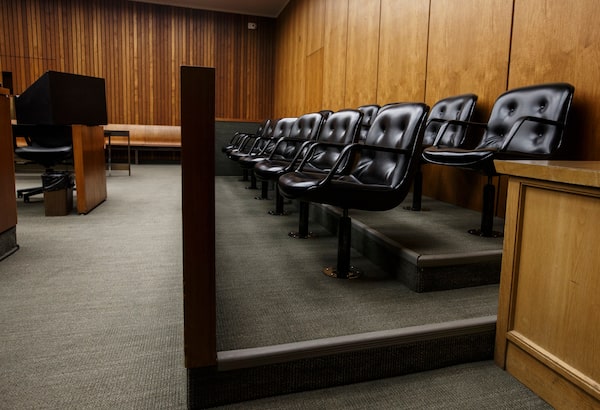
A jury box in a courtroom at the Edmonton Law Courts building in Edmonton is photographed on June 28, 2019.JASON FRANSON/The Canadian Press
The inside of a courtroom is a place most people rarely, if ever, find themselves, yet images of courtrooms and the legal and human drama therein are firmly lodged in the public consciousness.
From A Few Good Men and Law & Order to the People of the State of California v Orenthal James Simpson, all of us have looked inside the legal precinct as the balance between guilty and not guilty is weighed.
But those archetypal images in our minds are all American. Open courts are a foundational principle of Canadian law, and in non-pandemic times, courtroom doors across the country are generally open to any and all members of the public. Want to see Canadian justice being done? Walk right in. But Canada is unlike the United States, where the broadcast of real-life cases is allowed in many courts in all 50 states. In Canada, cameras are almost never permitted.
In late June, with access to Canadian courts shuttered by the pandemic, Ontario experimented with something new – the broadcast of the verdict in a case that had generated enormous public interest. In R. v. Theriault, better known as the Dafonte Miller case, an off-duty Toronto police officer was found guilty of assaulting Mr. Miller.
When the case was heard last fall and into January – heard, but of course, not broadcast – it already existed at the intersection of race and police misconduct, and was closely watched and heavily covered. By June, after the death in Minneapolis of George Floyd, public interest in the Miller case became even more intense.
Given the pandemic, it was decided there would be a broadcast of Ontario Superior Court Justice Joseph Di Luca delivering his verdict from an Oshawa courtroom, a place that, but for COVID-19, would have been full – meaning a few dozen spectators. Instead, with the courtroom empty, more than 20,000 people watched a livestream of the verdict – a verdict that took several hours to read, underlining the legal complexity of the case, and highlighting Canadian justice at work.
It was a win for open courts, and a pandemic experiment that should become a post-pandemic model.
Reading a detailed and nuanced verdict, however, is different from televising an entire criminal trial. The former is good; caution is warranted on the latter.
The broadcast of criminal cases is firmly fixed as an American thing in the minds of Canadians. The full OJ trial, in 493 long segments, is online. But Canada in fact is something of a pioneer in the broadcast for the most important legal cases.
In the early 1990s, three key cases were televised from the Supreme Court of Canada, including Sue Rodriguez’s right-to-die claim. Since then, CPAC has broadcast most cases from Canada’s highest court. There are small cameras mounted in the chamber, operated remotely. Justices at first were wary but soon forgot about them. As technology advanced, so did the court. Cases have been webcast and archived since 2009. If you miss a live case, you can check out CPAC’s Supreme Court highlights – advertised with “You be the judge!”
The U.S. is the opposite. While trial courts allow cameras, the U.S. Supreme Court absolutely does not. Until the pandemic, audio recordings were only made available at the end of a week. The pandemic produced a first: In May, Americans could tune in to live audio from their highest court.
We think the U.S., with video in lower courts but not at the top, has it backwards.
At both Supreme Courts, the only participants are lawyers and judges. There is no accused person. When cases are televised, no one – other than a lawyer who stumbles under questioning – risks being publicly humiliated.
Arguments in favour of more court broadcasts, including of criminal trials, lean heavily on the idea that it further opens the courts. There are strong counterarguments, starting with the bright light it would place on witnesses, and the potential reluctance of people to testify.
The Miller verdict broadcast was a big step for Canada’s courts. “We are seeing what is possible,” the province’s Attorney General said soon after. He’s right. This should be a precedent. The broadcast of key verdicts, the camera soberly directed at the judge, is reasonable – and bolsters the principle of open courts. It should be emulated across the country.
However, the principle of open courts, like any principle, is not unbounded. There’s no need for the 24/7 circus of a Canadian Court TV.
Keep your Opinions sharp and informed. Get the Opinion newsletter. Sign up today.